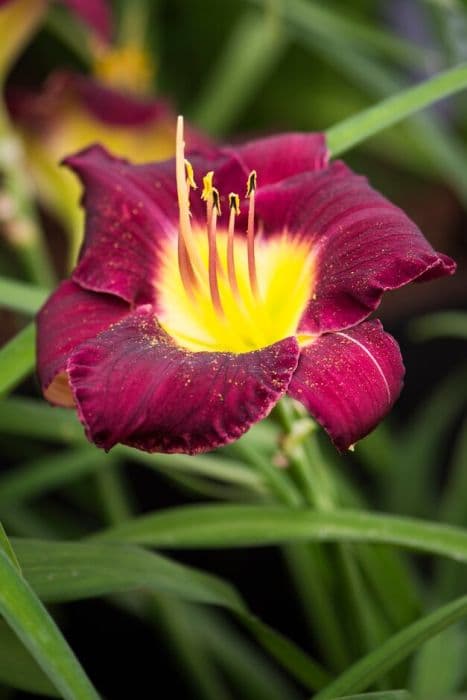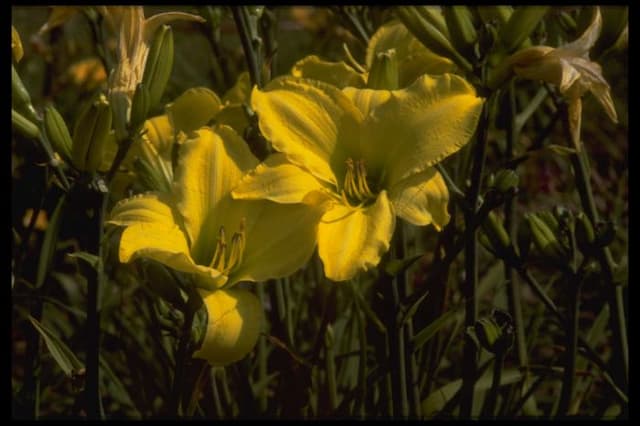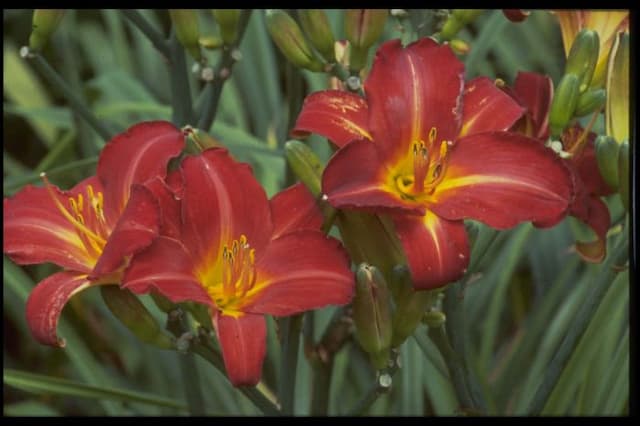Daylily Hemerocallis 'Sir Modred'

ABOUT
Hemerocallis 'Sir Modred', commonly known as the Daylily, is a striking perennial noted for its appealing aesthetic. The plant flaunts a clump-forming habit with arching, blade-like leaves that create a lush, grassy foundation. The foliage is typically a rich green in color, providing a fresh backdrop for the blossoms. The show-stopping feature of this Daylily is its flowers. 'Sir Modred' produces large, trumpet-shaped blooms that command attention. The petals display a deep, velvety purple hue, often with a subtle gradient that lightens near the throat of the flower. Each bloom may exhibit a darker purple eye or halo, which enhances the dramatic effect of the flower color. At the center, a contrasting yellow to greenish throat offers a bright focal point, adding depth and dimension to the flowers. These blossoms are typically borne on strong, upright scapes that rise gracefully above the foliage, creating a layered appearance in the garden. The flowers of the Daylily 'Sir Modred' are known for their individual beauty and are short-lived, usually opening for just a single day. However, the plant produces many buds that sequentially come into bloom, ensuring a long-lasting floral display throughout the blooming season. As a member of the Daylily family, 'Sir Modred' encapsulates the classic form and resilience of other daylilies, but with its own distinctive coloration and charm, making it a standout in any garden setting.
About this plant
 Names
NamesFamily
Hemerocallidaceae
Synonyms
Daylily
Common names
Hemerocallis 'Sir Modred'
 Toxicity
ToxicityTo humans
The Daylily 'Sir Modred,' like other daylilies (Hemerocallis), is not considered toxic to humans. In fact, some species within the Hemerocallis genus have edible parts that are consumed in certain cultures. However, it's important to note that one should not eat any part of a plant unless they are certain it is safe for human consumption, as there may be individual allergies or unrecognized species variations that could affect edibility and safety.
To pets
The Daylily 'Sir Modred' is known to be toxic to cats. Consumption can cause acute kidney failure in cats, which is a life-threatening condition. The symptoms of poisoning in cats can include vomiting, lethargy, inappetence, and increased thirst and urination, followed by a possible reduction in urine production as kidney failure progresses. Immediate veterinary care is required if a cat has ingested any part of a daylily plant. It is important to keep daylilies out of reach of cats to prevent accidental ingestion.
 Characteristics
CharacteristicsLife cycle
Perennials
Foliage type
Deciduous
Color of leaves
Green
Flower color
Purple
Height
2 feet [0.61 meters]
Spread
2 feet [0.61 meters]
Plant type
Herb
Hardiness zones
3
Native area
Asia
Benefits
 General Benefits
General Benefits- Easy to Grow - The Daylily 'Sir Modred' is known for its adaptability to a variety of soil conditions and its ease of cultivation.
- Drought Tolerant - Once established, it can withstand periods of drought, making it suitable for gardens with limited water availability.
- Long Blooming Period - This cultivar typically has a lengthy blooming period, providing colorful flowers for an extended period each summer.
- Attracts Pollinators - The bright flowers of the Daylily 'Sir Modred' attract bees, butterflies, and other pollinators to the garden.
- Low Maintenance - It requires minimal care once planted, making it ideal for gardeners of all levels of experience.
- Versatile Landscaping - Suitable for borders, flower beds, and as a ground cover, this plant can be used in a variety of garden designs.
- Rapid Growth - The Daylily can multiply quickly and fill in garden spaces, creating a lush, full garden appearance.
- Winter Hardy - Capable of surviving winter conditions in many climates, making it a reliable perennial option.
 Medical Properties
Medical PropertiesThis plant is not used for medical purposes.
 Air-purifying Qualities
Air-purifying QualitiesThis plant is not specifically known for air purifying qualities.
 Other Uses
Other Uses- Crafting natural dyes: The petals of the daylily can be used to create yellow, orange, and red natural dyes for fabrics and yarns.
- Floral arrangements: Daylily flowers can be used in fresh floral arrangements to add a splash of color and an exotic touch.
- Edible landscaping: Daylilies add aesthetic beauty to an edible landscape design, being both ornamental and a source of edible flowers and tubers.
- Photography subject: The unique and vibrant flowers of the daylily make it a popular subject for botanical photography.
- Companion planting: Daylilies can be planted alongside vegetables to assist in pest control due to their attractive nature to pollinators and beneficial insects.
- Water garden accent: Daylilies can be placed around ponds and water features to provide color and textural contrast.
- Erosion control: The root system of daylilies can help in stabilizing soil and preventing erosion in sloped gardens.
- Baking decoration: The non-toxic daylily petals can be used as edible decorations on cakes and pastries.
- Educational purposes: Daylilies can be used to teach botany and the life cycle of perennial plants in educational gardens.
- Culinary competitions: Daylily petals and buds are used by chefs in cooking contests to add unique flora elements to gourmet dishes.
Interesting Facts
 Feng Shui
Feng ShuiThe Daylily is not used in Feng Shui practice.
 Zodiac Sign Compitability
Zodiac Sign CompitabilityThe Daylily is not used in astrology practice.
 Plant Symbolism
Plant Symbolism- Daylily - The common name for Hemerocallis 'Sir Modred' is Daylily. This plant symbolizes the ephemeral nature of life, as each bloom typically lasts only for a day. It's a reminder to cherish each moment and to find beauty in transitory experiences.
- Motherhood - In Chinese culture, daylilies are associated with motherhood and maternal devotion due to their nurturing and daily rebirth of flowers.
- Forgetfulness - Daylilies can also represent forgetfulness or losing one's memory, as the flower itself 'forgets' each day by closing at night and often dying off to be replaced by a new bloom.
- Flirtation - Because of its many blooms throughout the blooming season, the daylily can symbolize flirtation or a playful heart.
- Coquetry - Similarly, the plenty of short-lived flowers can also stand for coquetry, representing a flirtatious behavior that is not meant to be taken seriously.
 Water
WaterTo properly water the daylily 'Sir Modred', the plant should be watered deeply enough that the soil is moistened to a depth of about 8-10 inches to encourage deep rooting. Watering should take place approximately once a week, but this frequency should be adjusted depending on weather conditions and soil type. For instance, during hot or dry periods, more frequent watering may be needed. In terms of quantity, provide about 1 to 1.5 gallons of water per plant for each watering session, ensuring that the water is delivered at the base of the plant and not on the foliage to prevent fungal diseases. Over-watering as well as under-watering should be avoided to maintain healthy growth and to ensure abundant flowering.
 Light
LightThe daylily 'Sir Modred' flourishes under full sunlight to partial shade. Ideally, it should receive at least six hours of direct sunlight daily for optimal growth and bloom production. A spot that enjoys morning sunlight with some afternoon shade is also beneficial, especially in climates with intensely hot summers. Providing the right amount of light ensures vibrant blooms and strong, healthy foliage.
 Temperature
TemperatureDaylilies such as 'Sir Modred' prefer moderately warm conditions and are hardy in a wide range of temperatures. They can survive winter temperatures down to about -20°F and are heat tolerant up to about 90°F. However, the ideal temperature range for daylilies is from about 60°F to 75°F. Daylilies are adaptable to many conditions but may require extra care if temperatures exceed these ranges for prolonged periods.
 Pruning
PruningPruning the daylily 'Sir Modred' involves deadheading spent flowers to promote further blooming and to maintain a tidy appearance. Remove old foliage in early spring before new growth begins. Pruning should be done regularly throughout the blooming season to encourage the plant to produce more flowers. The best time to do a significant cut back is after the plant has finished blooming, usually in late summer or early fall.
 Cleaning
CleaningAs needed
 Soil
SoilDaylilies (Hemerocallis 'Sir Modred') thrive best in moderately fertile, well-drained soil with a pH of 6 to 6.5. A mix of loamy garden soil, compost, and a bit of sand for drainage is ideal. Amending your soil with organic matter will help provide the nutrients they need for robust growth.
 Repotting
RepottingDaylilies, including 'Sir Modred', are typically not grown in containers that require repotting but are planted outdoors. If grown in a pot, repot every 2-3 years or when the container is crowded.
 Humidity & Misting
Humidity & MistingDaylilies (Hemerocallis 'Sir Modred') are tolerant of a range of humidity conditions and thrive in the average outdoor humidity levels found in their growing zones.
 Suitable locations
Suitable locationsIndoor
Ensure bright light and good airflow for growing daylilies indoors.
Outdoor
Plant in full sun to part shade in well-drained soil.
Hardiness zone
3-9 USDA
 Life cycle
Life cycleThe Hemerocallis 'Sir Modred', commonly known as the Daylily, begins its life cycle when a seed germinates in moist, well-draining soil. After germination, the plant emerges as a seedling with a small set of true leaves and begins to develop a root system. As it matures into a vegetative state, the daylily forms a clump of grass-like foliage and strengthens its root structure, known as the rhizome. Following this, it enters the flowering stage, usually in the late spring or early summer, producing tall scapes topped with large, colorful flowers which typically last just one day. After blooming, the flowers wither and are replaced by seed pods if pollination occurs. The plant then enters a period of dormancy during the colder months, conserving energy to repeat its life cycle in the following growing season.
 Propogation
PropogationPropogation time
Late summer to early fall
The Hemerocallis 'Sir Modred', commonly known as the Daylily, is typically propagated through division, which is done in early spring or after the plant has finished blooming in late summer or early fall. This method involves digging up the clump of the daylily with a spade or garden fork and gently separating the fans of leaves with roots attached. Each fan should have a portion of the root system. The divisions can then be replanted at the same soil depth they were previously growing at, and they should be spaced about 18 to 24 inches apart (approximately 45 to 60 centimeters) to allow room for growth. Water the new divisions thoroughly to help establish them. This method is easy and helps to rejuvenate older clumps that may be underperforming, while also increasing your stock of daylilies.









